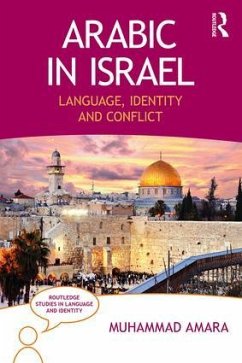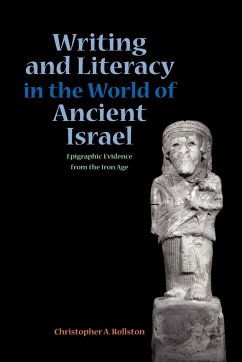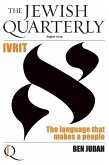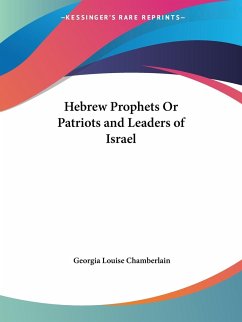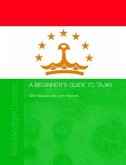- Broschiertes Buch
- Merkliste
- Auf die Merkliste
- Bewerten Bewerten
- Teilen
- Produkt teilen
- Produkterinnerung
- Produkterinnerung
In Arabic in Israel, Muhammad Amara analyses the status of Arabic following the creation of the State of Israel and documents its impact on the individual and collective identity of Israel's Palestinian Arab citizens. The interplay of language and identity in conflict situations is also examined. This work represents the culmination of many years of research on Arabic linguistic repertoire and educational policy regarding the language of the Palestinian citizens of Israel. It draws all of these factors together while linking them to local, regional and global developments. Its perspective is…mehr
Andere Kunden interessierten sich auch für
![Writing and Literacy in the World of Ancient Israel Writing and Literacy in the World of Ancient Israel]() Chris A. RollstonWriting and Literacy in the World of Ancient Israel24,99 €
Chris A. RollstonWriting and Literacy in the World of Ancient Israel24,99 €![The Hebrew Workbook The Hebrew Workbook]() Miiko ShaffierThe Hebrew Workbook18,99 €
Miiko ShaffierThe Hebrew Workbook18,99 €![Ivrit Ivrit]() Ivrit27,99 €
Ivrit27,99 €![READ HEBREW! READ HEBREW!]() Michelle GeftREAD HEBREW!20,99 €
Michelle GeftREAD HEBREW!20,99 €![Hebrew Prophets Or Patriots and Leaders of Israel Hebrew Prophets Or Patriots and Leaders of Israel]() Georgia Louise ChamberlainHebrew Prophets Or Patriots and Leaders of Israel29,99 €
Georgia Louise ChamberlainHebrew Prophets Or Patriots and Leaders of Israel29,99 €![Learn to Read Modern Hebrew in 5 Days Learn to Read Modern Hebrew in 5 Days]() David Ben ZakenLearn to Read Modern Hebrew in 5 Days15,99 €
David Ben ZakenLearn to Read Modern Hebrew in 5 Days15,99 €![A Beginners' Guide to Tajiki A Beginners' Guide to Tajiki]() Azim BaizoyevA Beginners' Guide to Tajiki76,99 €
Azim BaizoyevA Beginners' Guide to Tajiki76,99 €-
-
-
In Arabic in Israel, Muhammad Amara analyses the status of Arabic following the creation of the State of Israel and documents its impact on the individual and collective identity of Israel's Palestinian Arab citizens. The interplay of language and identity in conflict situations is also examined. This work represents the culmination of many years of research on Arabic linguistic repertoire and educational policy regarding the language of the Palestinian citizens of Israel. It draws all of these factors together while linking them to local, regional and global developments. Its perspective is interdisciplinary and, as such, examines the topic from a number of angles including linguistic, social, cultural and political.
Hinweis: Dieser Artikel kann nur an eine deutsche Lieferadresse ausgeliefert werden.
Hinweis: Dieser Artikel kann nur an eine deutsche Lieferadresse ausgeliefert werden.
Produktdetails
- Produktdetails
- Verlag: Routledge
- Seitenzahl: 228
- Erscheinungstermin: 13. September 2017
- Englisch
- Abmessung: 234mm x 156mm x 12mm
- Gewicht: 354g
- ISBN-13: 9781138063556
- ISBN-10: 113806355X
- Artikelnr.: 49208686
- Herstellerkennzeichnung
- Libri GmbH
- Europaallee 1
- 36244 Bad Hersfeld
- gpsr@libri.de
- Verlag: Routledge
- Seitenzahl: 228
- Erscheinungstermin: 13. September 2017
- Englisch
- Abmessung: 234mm x 156mm x 12mm
- Gewicht: 354g
- ISBN-13: 9781138063556
- ISBN-10: 113806355X
- Artikelnr.: 49208686
- Herstellerkennzeichnung
- Libri GmbH
- Europaallee 1
- 36244 Bad Hersfeld
- gpsr@libri.de
Muhammad Amara is the head of Graduate Studies at Beit Berl College, Israel,a lecturer at Al-Qasemi College, and president of the Israeli Society for the Study of Language and Society.
List of tables, figure, pictures and mapsPreface
Acknowledgements
Chapter 1 Language, identity and conflict
1.1 Introduction
1.1 Identity and identities
1.1.1 Conflicting identities: Palestinian-Jewish relationships inside
Israel
1.2 Language and social identity
1.2.1 The Arabic language and social identity
1.2.2 Language and identity in Israel
1.3 The vitality of Arabic in Israel
1.4 Language and conflict
1.4.1 The role of language in the Arab-Israeli conflict
1.5 Conclusion
Chapter 2 Internal and external challenges of the Arabic language
2. Introduction
2.1 Internal challenges
2.1.1 Diglossia: old and new challenges
2.1.2 Modernization and the Arabic language
2.2 External challenges
2.2.1 Colonialism, globalization and the Arabic language
2.3 Policy towards Arabic in the Arab world: .encountering challenges
2.4 Conclusion
Chapter 3 Internal and regional contexts and the Arabic language in Israel
3. Introduction
3.1 Internal contexts
3.2 Regional contexts
3.3 Conclusion
Chapter 4 The status of the Arabic language in Israel
4.1 The linguistic situation in Israel
4.2 The status of Arabic in Israel
4.3 Conclusion
Chapter 5 Features of the Arabic language in Israel
5.1 Introduction
5.2 Arabic in Israel
5.2.1 Is there a unique variety of Arabic in Israel?
5.2.2 Influences from other Arabic varieties
5.3 Conclusion
Chapter 6 Arabic in the shadow of Hebraization
6.1 Hebrew is the dominant language in Israel
6.1.1 Building the new Jewish Israeli identity
6.1.2 Putting Hebrew on the national agenda
6.1.3 Teaching Hebrew
6.1.4 Hebraization consequences
6.2 Ideologized Hebrew and its teaching to Palestinian pupils in Israel
6.2.1 Attitudes towards teaching Hebrew to Palestinian Arabs
6.2.2 The Policy of teaching Hebrew: goals and curricula
6.2.3 A new curriculum
6.2.4 Textbooks and contents
6.2.5 Consequences of Hebraization for teaching
6.3 The penetration of Hebrew into the 'heart of Arabic': borrowing
6.3.1 Introduction
6.3.2 Culture contact and its linguistic reflections
6.3.3 The importance of the study of Hebrew
6.3.4 The knowledge and use of Hebrew
6.3.5 Borrowing lexical items from Hebrew: integration and diffusion
6.3.6 Borrowing and its linguistic characteristics
6.3.7 The consequences of Hebraization on borrowing
Chapter 7 English in the Palestinian linguistic repertoire in Israel
7.1 Introduction
7.2 English teaching in the Palestinian schools in Israel
7.2.1 The current English curriculum
7.2.2 Textbooks
7.2.3 Achievements
7.3 Borrowing from English
7.4 Globalization and English
7.5 Writing with Latin and Hebrew letters
7.6 Conclusion
Chapter 8 Hebraization of Arabic place names
8.1 Introduction
8.2 Hebraizing names: the translation of ideological orientation and
political thinking
8.3 Conclusion
Chapter 9 The current linguistic landscape in the Palestinian Arab
localities in Israel
9.1 Linguistic landscape: a brief background
9.1.1 Studies on linguistic landscape in Israel
9.2 The Palestinian Arab linguistic landscape in Israel
9.2.1 Hebrew and Hebraization
9.2.2 Palestinian Arab uniqueness
9.2.3 Conclusion
9.3 The linguistic landscape from a different perspective: Umm-el-Fahm as a
case study
9.3.1 Umm-el-Fahm: background
9.3.2 The linguistic landscape in the city
9.3.3 Conclusion
Chapter 10 The Arabic language in the Palestinian Arab education system
10.1 Introduction
10.2 The effect of the Arabic curricula on the Palestinian Arab identity
10.3 The hurdles blocking the achievement of high competence in Standard
Arabic
10.4 What is the role of the Arabic language in the Palestinian Arab
education system?
10.5 Conclusion
Chapter 11 Teaching Arabic in Jewish schools: language of the neighbour or
the enemy?
11.1 Introduction
11.2 Teaching the Arabic language
11.3 Jewish attitudes towards the Arabic language
11.4 Goals of teaching Arabic
11.5 Bilingual schools: the Hand-in-Hand schools
11.6 Conclusion
Chapter 12 Language ideology and attitudes: Arabic language academies and
future vision documents
12.1 Language ideology and attitudes towards Arabic
12.1.1 The Communist party and the Democratic Front
12.1.2 Balad
12.1.3 The Islamic Movement
12.1.4 Civil organizations
12.2 Survey
12.3 Conclusion
12.4 Arabic language academies in the Israeli context: between the research
role and nationalist aspirations
12.4.1Arabic language academies
12.4.2 Arabic language academies in Israel
12.4.3 Conclusion
12.5 The role of Arabic according to future vision documents
12.5.1 Introduction
12.5.2 Arabic in the future vision documents
12.5.3 Conclusion
Chapter 13 Epilogue: facing the challenges
13.1 Challenges of the Arabic language
13.2 Facing the challenges
13.2.1 Arabic as a strategic choice for building an Arab knowledge society
13.2.2 Meeting the challenges: building a framework
13.3 Practical proposals
13.4 Conclusion
Index
Acknowledgements
Chapter 1 Language, identity and conflict
1.1 Introduction
1.1 Identity and identities
1.1.1 Conflicting identities: Palestinian-Jewish relationships inside
Israel
1.2 Language and social identity
1.2.1 The Arabic language and social identity
1.2.2 Language and identity in Israel
1.3 The vitality of Arabic in Israel
1.4 Language and conflict
1.4.1 The role of language in the Arab-Israeli conflict
1.5 Conclusion
Chapter 2 Internal and external challenges of the Arabic language
2. Introduction
2.1 Internal challenges
2.1.1 Diglossia: old and new challenges
2.1.2 Modernization and the Arabic language
2.2 External challenges
2.2.1 Colonialism, globalization and the Arabic language
2.3 Policy towards Arabic in the Arab world: .encountering challenges
2.4 Conclusion
Chapter 3 Internal and regional contexts and the Arabic language in Israel
3. Introduction
3.1 Internal contexts
3.2 Regional contexts
3.3 Conclusion
Chapter 4 The status of the Arabic language in Israel
4.1 The linguistic situation in Israel
4.2 The status of Arabic in Israel
4.3 Conclusion
Chapter 5 Features of the Arabic language in Israel
5.1 Introduction
5.2 Arabic in Israel
5.2.1 Is there a unique variety of Arabic in Israel?
5.2.2 Influences from other Arabic varieties
5.3 Conclusion
Chapter 6 Arabic in the shadow of Hebraization
6.1 Hebrew is the dominant language in Israel
6.1.1 Building the new Jewish Israeli identity
6.1.2 Putting Hebrew on the national agenda
6.1.3 Teaching Hebrew
6.1.4 Hebraization consequences
6.2 Ideologized Hebrew and its teaching to Palestinian pupils in Israel
6.2.1 Attitudes towards teaching Hebrew to Palestinian Arabs
6.2.2 The Policy of teaching Hebrew: goals and curricula
6.2.3 A new curriculum
6.2.4 Textbooks and contents
6.2.5 Consequences of Hebraization for teaching
6.3 The penetration of Hebrew into the 'heart of Arabic': borrowing
6.3.1 Introduction
6.3.2 Culture contact and its linguistic reflections
6.3.3 The importance of the study of Hebrew
6.3.4 The knowledge and use of Hebrew
6.3.5 Borrowing lexical items from Hebrew: integration and diffusion
6.3.6 Borrowing and its linguistic characteristics
6.3.7 The consequences of Hebraization on borrowing
Chapter 7 English in the Palestinian linguistic repertoire in Israel
7.1 Introduction
7.2 English teaching in the Palestinian schools in Israel
7.2.1 The current English curriculum
7.2.2 Textbooks
7.2.3 Achievements
7.3 Borrowing from English
7.4 Globalization and English
7.5 Writing with Latin and Hebrew letters
7.6 Conclusion
Chapter 8 Hebraization of Arabic place names
8.1 Introduction
8.2 Hebraizing names: the translation of ideological orientation and
political thinking
8.3 Conclusion
Chapter 9 The current linguistic landscape in the Palestinian Arab
localities in Israel
9.1 Linguistic landscape: a brief background
9.1.1 Studies on linguistic landscape in Israel
9.2 The Palestinian Arab linguistic landscape in Israel
9.2.1 Hebrew and Hebraization
9.2.2 Palestinian Arab uniqueness
9.2.3 Conclusion
9.3 The linguistic landscape from a different perspective: Umm-el-Fahm as a
case study
9.3.1 Umm-el-Fahm: background
9.3.2 The linguistic landscape in the city
9.3.3 Conclusion
Chapter 10 The Arabic language in the Palestinian Arab education system
10.1 Introduction
10.2 The effect of the Arabic curricula on the Palestinian Arab identity
10.3 The hurdles blocking the achievement of high competence in Standard
Arabic
10.4 What is the role of the Arabic language in the Palestinian Arab
education system?
10.5 Conclusion
Chapter 11 Teaching Arabic in Jewish schools: language of the neighbour or
the enemy?
11.1 Introduction
11.2 Teaching the Arabic language
11.3 Jewish attitudes towards the Arabic language
11.4 Goals of teaching Arabic
11.5 Bilingual schools: the Hand-in-Hand schools
11.6 Conclusion
Chapter 12 Language ideology and attitudes: Arabic language academies and
future vision documents
12.1 Language ideology and attitudes towards Arabic
12.1.1 The Communist party and the Democratic Front
12.1.2 Balad
12.1.3 The Islamic Movement
12.1.4 Civil organizations
12.2 Survey
12.3 Conclusion
12.4 Arabic language academies in the Israeli context: between the research
role and nationalist aspirations
12.4.1Arabic language academies
12.4.2 Arabic language academies in Israel
12.4.3 Conclusion
12.5 The role of Arabic according to future vision documents
12.5.1 Introduction
12.5.2 Arabic in the future vision documents
12.5.3 Conclusion
Chapter 13 Epilogue: facing the challenges
13.1 Challenges of the Arabic language
13.2 Facing the challenges
13.2.1 Arabic as a strategic choice for building an Arab knowledge society
13.2.2 Meeting the challenges: building a framework
13.3 Practical proposals
13.4 Conclusion
Index
List of tables, figure, pictures and mapsPreface
Acknowledgements
Chapter 1 Language, identity and conflict
1.1 Introduction
1.1 Identity and identities
1.1.1 Conflicting identities: Palestinian-Jewish relationships inside
Israel
1.2 Language and social identity
1.2.1 The Arabic language and social identity
1.2.2 Language and identity in Israel
1.3 The vitality of Arabic in Israel
1.4 Language and conflict
1.4.1 The role of language in the Arab-Israeli conflict
1.5 Conclusion
Chapter 2 Internal and external challenges of the Arabic language
2. Introduction
2.1 Internal challenges
2.1.1 Diglossia: old and new challenges
2.1.2 Modernization and the Arabic language
2.2 External challenges
2.2.1 Colonialism, globalization and the Arabic language
2.3 Policy towards Arabic in the Arab world: .encountering challenges
2.4 Conclusion
Chapter 3 Internal and regional contexts and the Arabic language in Israel
3. Introduction
3.1 Internal contexts
3.2 Regional contexts
3.3 Conclusion
Chapter 4 The status of the Arabic language in Israel
4.1 The linguistic situation in Israel
4.2 The status of Arabic in Israel
4.3 Conclusion
Chapter 5 Features of the Arabic language in Israel
5.1 Introduction
5.2 Arabic in Israel
5.2.1 Is there a unique variety of Arabic in Israel?
5.2.2 Influences from other Arabic varieties
5.3 Conclusion
Chapter 6 Arabic in the shadow of Hebraization
6.1 Hebrew is the dominant language in Israel
6.1.1 Building the new Jewish Israeli identity
6.1.2 Putting Hebrew on the national agenda
6.1.3 Teaching Hebrew
6.1.4 Hebraization consequences
6.2 Ideologized Hebrew and its teaching to Palestinian pupils in Israel
6.2.1 Attitudes towards teaching Hebrew to Palestinian Arabs
6.2.2 The Policy of teaching Hebrew: goals and curricula
6.2.3 A new curriculum
6.2.4 Textbooks and contents
6.2.5 Consequences of Hebraization for teaching
6.3 The penetration of Hebrew into the 'heart of Arabic': borrowing
6.3.1 Introduction
6.3.2 Culture contact and its linguistic reflections
6.3.3 The importance of the study of Hebrew
6.3.4 The knowledge and use of Hebrew
6.3.5 Borrowing lexical items from Hebrew: integration and diffusion
6.3.6 Borrowing and its linguistic characteristics
6.3.7 The consequences of Hebraization on borrowing
Chapter 7 English in the Palestinian linguistic repertoire in Israel
7.1 Introduction
7.2 English teaching in the Palestinian schools in Israel
7.2.1 The current English curriculum
7.2.2 Textbooks
7.2.3 Achievements
7.3 Borrowing from English
7.4 Globalization and English
7.5 Writing with Latin and Hebrew letters
7.6 Conclusion
Chapter 8 Hebraization of Arabic place names
8.1 Introduction
8.2 Hebraizing names: the translation of ideological orientation and
political thinking
8.3 Conclusion
Chapter 9 The current linguistic landscape in the Palestinian Arab
localities in Israel
9.1 Linguistic landscape: a brief background
9.1.1 Studies on linguistic landscape in Israel
9.2 The Palestinian Arab linguistic landscape in Israel
9.2.1 Hebrew and Hebraization
9.2.2 Palestinian Arab uniqueness
9.2.3 Conclusion
9.3 The linguistic landscape from a different perspective: Umm-el-Fahm as a
case study
9.3.1 Umm-el-Fahm: background
9.3.2 The linguistic landscape in the city
9.3.3 Conclusion
Chapter 10 The Arabic language in the Palestinian Arab education system
10.1 Introduction
10.2 The effect of the Arabic curricula on the Palestinian Arab identity
10.3 The hurdles blocking the achievement of high competence in Standard
Arabic
10.4 What is the role of the Arabic language in the Palestinian Arab
education system?
10.5 Conclusion
Chapter 11 Teaching Arabic in Jewish schools: language of the neighbour or
the enemy?
11.1 Introduction
11.2 Teaching the Arabic language
11.3 Jewish attitudes towards the Arabic language
11.4 Goals of teaching Arabic
11.5 Bilingual schools: the Hand-in-Hand schools
11.6 Conclusion
Chapter 12 Language ideology and attitudes: Arabic language academies and
future vision documents
12.1 Language ideology and attitudes towards Arabic
12.1.1 The Communist party and the Democratic Front
12.1.2 Balad
12.1.3 The Islamic Movement
12.1.4 Civil organizations
12.2 Survey
12.3 Conclusion
12.4 Arabic language academies in the Israeli context: between the research
role and nationalist aspirations
12.4.1Arabic language academies
12.4.2 Arabic language academies in Israel
12.4.3 Conclusion
12.5 The role of Arabic according to future vision documents
12.5.1 Introduction
12.5.2 Arabic in the future vision documents
12.5.3 Conclusion
Chapter 13 Epilogue: facing the challenges
13.1 Challenges of the Arabic language
13.2 Facing the challenges
13.2.1 Arabic as a strategic choice for building an Arab knowledge society
13.2.2 Meeting the challenges: building a framework
13.3 Practical proposals
13.4 Conclusion
Index
Acknowledgements
Chapter 1 Language, identity and conflict
1.1 Introduction
1.1 Identity and identities
1.1.1 Conflicting identities: Palestinian-Jewish relationships inside
Israel
1.2 Language and social identity
1.2.1 The Arabic language and social identity
1.2.2 Language and identity in Israel
1.3 The vitality of Arabic in Israel
1.4 Language and conflict
1.4.1 The role of language in the Arab-Israeli conflict
1.5 Conclusion
Chapter 2 Internal and external challenges of the Arabic language
2. Introduction
2.1 Internal challenges
2.1.1 Diglossia: old and new challenges
2.1.2 Modernization and the Arabic language
2.2 External challenges
2.2.1 Colonialism, globalization and the Arabic language
2.3 Policy towards Arabic in the Arab world: .encountering challenges
2.4 Conclusion
Chapter 3 Internal and regional contexts and the Arabic language in Israel
3. Introduction
3.1 Internal contexts
3.2 Regional contexts
3.3 Conclusion
Chapter 4 The status of the Arabic language in Israel
4.1 The linguistic situation in Israel
4.2 The status of Arabic in Israel
4.3 Conclusion
Chapter 5 Features of the Arabic language in Israel
5.1 Introduction
5.2 Arabic in Israel
5.2.1 Is there a unique variety of Arabic in Israel?
5.2.2 Influences from other Arabic varieties
5.3 Conclusion
Chapter 6 Arabic in the shadow of Hebraization
6.1 Hebrew is the dominant language in Israel
6.1.1 Building the new Jewish Israeli identity
6.1.2 Putting Hebrew on the national agenda
6.1.3 Teaching Hebrew
6.1.4 Hebraization consequences
6.2 Ideologized Hebrew and its teaching to Palestinian pupils in Israel
6.2.1 Attitudes towards teaching Hebrew to Palestinian Arabs
6.2.2 The Policy of teaching Hebrew: goals and curricula
6.2.3 A new curriculum
6.2.4 Textbooks and contents
6.2.5 Consequences of Hebraization for teaching
6.3 The penetration of Hebrew into the 'heart of Arabic': borrowing
6.3.1 Introduction
6.3.2 Culture contact and its linguistic reflections
6.3.3 The importance of the study of Hebrew
6.3.4 The knowledge and use of Hebrew
6.3.5 Borrowing lexical items from Hebrew: integration and diffusion
6.3.6 Borrowing and its linguistic characteristics
6.3.7 The consequences of Hebraization on borrowing
Chapter 7 English in the Palestinian linguistic repertoire in Israel
7.1 Introduction
7.2 English teaching in the Palestinian schools in Israel
7.2.1 The current English curriculum
7.2.2 Textbooks
7.2.3 Achievements
7.3 Borrowing from English
7.4 Globalization and English
7.5 Writing with Latin and Hebrew letters
7.6 Conclusion
Chapter 8 Hebraization of Arabic place names
8.1 Introduction
8.2 Hebraizing names: the translation of ideological orientation and
political thinking
8.3 Conclusion
Chapter 9 The current linguistic landscape in the Palestinian Arab
localities in Israel
9.1 Linguistic landscape: a brief background
9.1.1 Studies on linguistic landscape in Israel
9.2 The Palestinian Arab linguistic landscape in Israel
9.2.1 Hebrew and Hebraization
9.2.2 Palestinian Arab uniqueness
9.2.3 Conclusion
9.3 The linguistic landscape from a different perspective: Umm-el-Fahm as a
case study
9.3.1 Umm-el-Fahm: background
9.3.2 The linguistic landscape in the city
9.3.3 Conclusion
Chapter 10 The Arabic language in the Palestinian Arab education system
10.1 Introduction
10.2 The effect of the Arabic curricula on the Palestinian Arab identity
10.3 The hurdles blocking the achievement of high competence in Standard
Arabic
10.4 What is the role of the Arabic language in the Palestinian Arab
education system?
10.5 Conclusion
Chapter 11 Teaching Arabic in Jewish schools: language of the neighbour or
the enemy?
11.1 Introduction
11.2 Teaching the Arabic language
11.3 Jewish attitudes towards the Arabic language
11.4 Goals of teaching Arabic
11.5 Bilingual schools: the Hand-in-Hand schools
11.6 Conclusion
Chapter 12 Language ideology and attitudes: Arabic language academies and
future vision documents
12.1 Language ideology and attitudes towards Arabic
12.1.1 The Communist party and the Democratic Front
12.1.2 Balad
12.1.3 The Islamic Movement
12.1.4 Civil organizations
12.2 Survey
12.3 Conclusion
12.4 Arabic language academies in the Israeli context: between the research
role and nationalist aspirations
12.4.1Arabic language academies
12.4.2 Arabic language academies in Israel
12.4.3 Conclusion
12.5 The role of Arabic according to future vision documents
12.5.1 Introduction
12.5.2 Arabic in the future vision documents
12.5.3 Conclusion
Chapter 13 Epilogue: facing the challenges
13.1 Challenges of the Arabic language
13.2 Facing the challenges
13.2.1 Arabic as a strategic choice for building an Arab knowledge society
13.2.2 Meeting the challenges: building a framework
13.3 Practical proposals
13.4 Conclusion
Index

